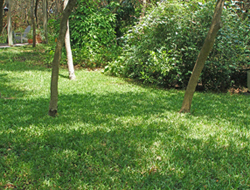|
Provide a natural, comfortable,
and safe setting for activities. |
|
Release oxygen and cool the air. |
|
Control pollution and reduce soil
erosion. |
|
A well maintained lawn can enhance the "curb appeal" adding as much as 15
percent to the value of a home. |
|
Turfgrass traps and removes dust
and dirt from the air. |
|
2,500 square feet of lawn absorb
carbon dioxide from the atmosphere, release enough oxygen
for a family of four to breathe. |
|
On a hot summer day, lawns will be
30 degrees cooler than asphalt or rock and 14 degrees cooler
than bare soil. |
|
Turfgrass acts as a natural filter,
reducing pollution by purifying the water passing through its
root zone. |
|
Turfgrass is the most
cost-effective method for controlling wind and water erosion. |
|
A sodded lawn will absorb greater
amounts of rain than a seeded lawn; even after three years of
growth. |

